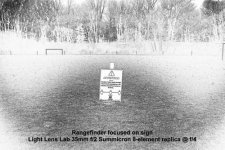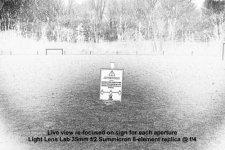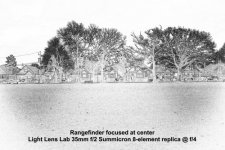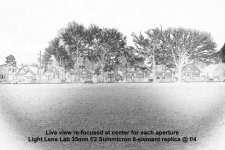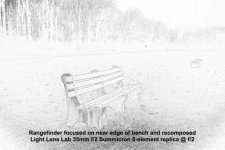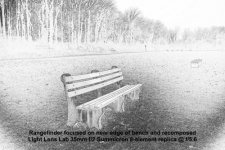OK, here is a
link to a Google Drive folder with a bunch of images.
Images are watermarked to indicate whether the lens was rangefinder focused or live view focused and the taking aperture.
For rangefinder focus, it means focus was set once and not changed as the lens was stopped down or the scene recomposed.
For live view focus, each image was refocused at the taking aperture to optimize focus at the center of the frame.
The first 9 images have Find Edges applied in Photoshop to give the 'focus peaking' effect to highlight the plane of best sharpness and illustrate field curvature characteristics as the lens is stopped down. This sequence is in half stops from wide open to f/8. The object in the center of the image is a small can I used to more easily focus the rangefinder and to give a reference point for focus shift as the lens is stopped down.
The next set is the sign in the park that was posted earlier, but including both the Find Edges version and normal version. In this set, note how focus extends behind the sign in the center of the image and the text on the sign loses critical sharpness. In the live view focused set the text remains sharp but the plane of focus in the outer 2/3 of the image is pulled significantly forward.
The following set is the row of houses opposite a park field, also posted earlier. Again, both the Find Edges version and normal version. Note how sharpness changes along the row of houses depending on whether the lens was rangefinder or live view focused.
The next set of the large white house/mansion is basically a repeat of the row of houses test, but includes the full aperture range. You'll note that f/11 is the point where across-frame sharpness is best.
Then a set of a tree flanked by two benches. This set was only rangefinder focused. You'll note that as the lens is stopped down, the tree goes out of focus and the small white cabin and area around it far in the background becomes sharp. Meanwhile the benches stay in focus. This IMO is a prime example of the "W" field curvature/focus shift exhibited by my copy.
The next set of a small building placed in the left third of the image: it was RF focused on the front of the building and the scene recomposed. As the lens is stopped down, you'll note the building remains consistently sharp, though the trees in the center of the image lose sharpness until recovered by depth of field. In this case, with the primary point of interest off center, the loss of central sharpness is less disturbing to my eyes.
Kitchen Garden sign set is similar to the earlier sign set, though includes f/11 and f/16.
The wooden fence set is similar to the earlier tree flanked by benches. Note how the fence goes out of focus in the center as the focus shifts to the background. And when live view focused, how the outer thirds of the image become very soft because placement of best focus in the center has pulled the peripheral field curvature forward of the fence.
Finally a few of a tolerant spouse to add a human element to the tests. The first two at a farther distance were both at f/4. The first was rangefinder focused and the second was live view focused.
The head & shoulder distance set includes rangefinder focused from f/2-5.6 and live view focused at f/4 and f/5.6 to highlight the sharpness difference at the two aperture settings I find most affected by the combined field curvature and focus shift of my copy. This would also be a more typical use case for me where normally I'd be shooting hand-held via the rangefinder (though these were locked down on a tripod for the purpose of the test). Were I desiring the reduced background blur of f/4 or f/5.6, it would be very difficult for me to nail sharp 'on the fly' results via the rangefinder with a centrally placed subject.
I recommend downloading the images and browsing them with your preferred image viewing/editing app rather than viewing in Google Drive to more easily flip between and compare images.
I also realize there are a lot of images and for those happy with their results with the lens, likely won't be of much interest. But I hope these at least illustrate what I've experienced with my copy and I would like to know if others see similar behavior in their images with this lens.
Thanks!
Ron


